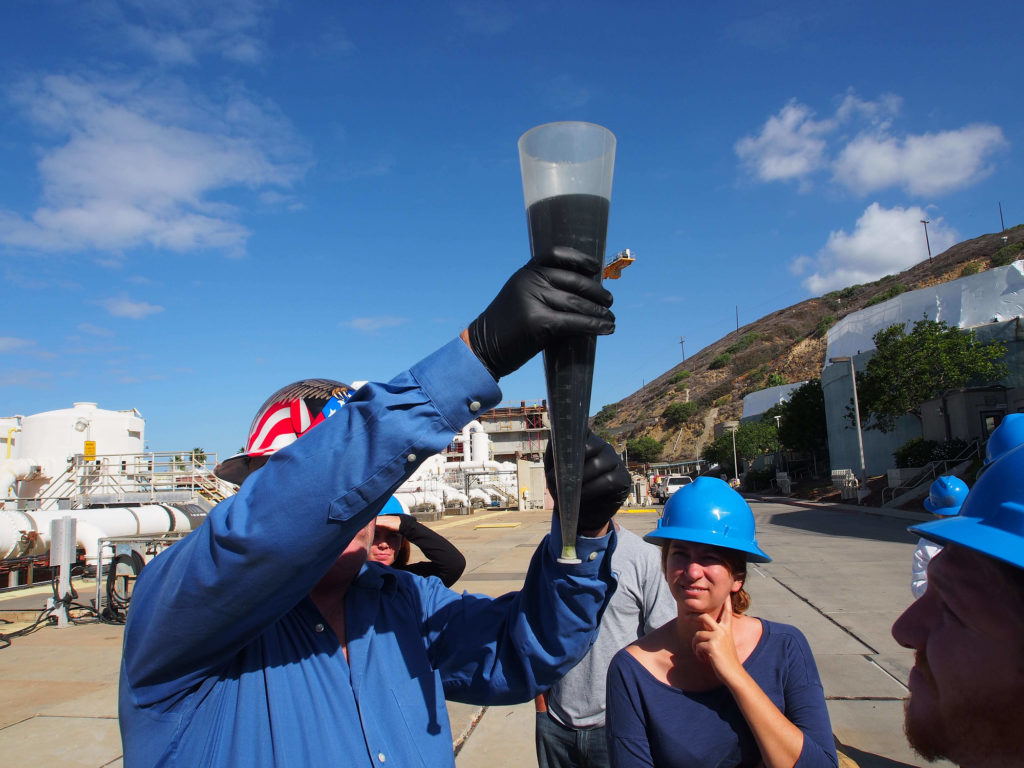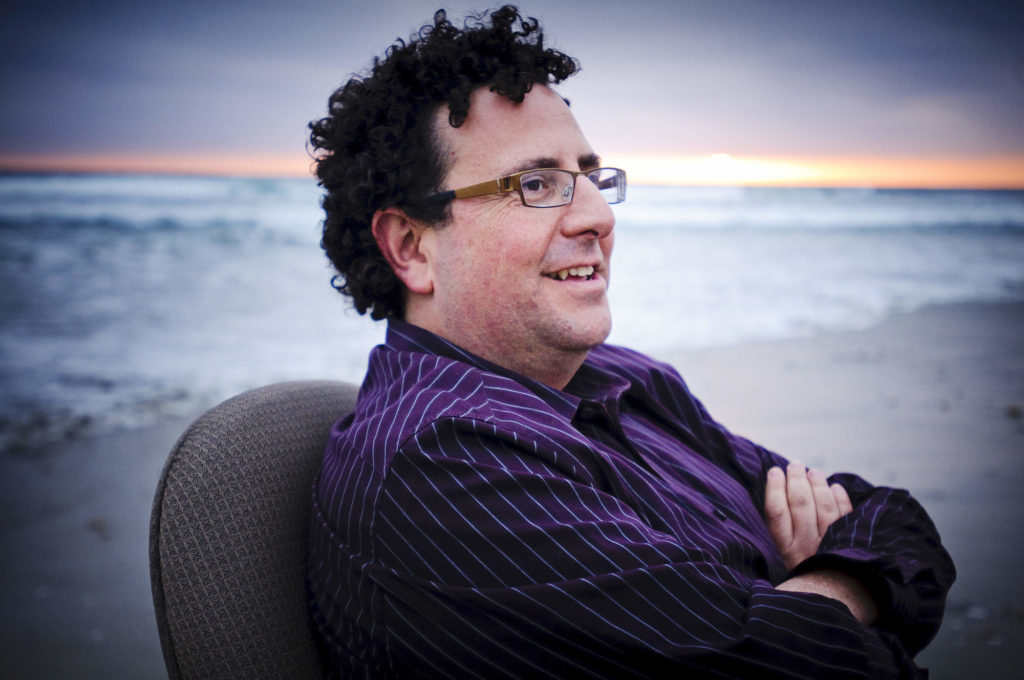What’s In The Water? What’s In A Word?
By: ajcarapella
In the increasingly thirsty San Diego area, San Diego Coastkeeper crafted the vision and the words to offer a solution to the worsening water woes.

For more than 25 years, the City of San Diego had a pass to pollute signed by the EPA itself.
More than half of the city’s water is pumped over mountains and through desert from more than 500 miles away, and for many years, after it had been used, some of the least-treated sewage in America was dumped straight into the Pacific Ocean. After the passage of the 1972 Clean Water Act, the lower level to which San Diego treated its sewage became illegal, but their sewage treatment plant was perched on the edge of a cliff over the Pacific Ocean making an upgrade costly and complicated. In fact, the upgrade was just costly and complicated enough for the resource-stressed EPA to offer legal sympathy in the form of a five-year pollution waiver, which was renewed every five years.
For years, San Diego Coastkeeper Bruce Reznik and his predecessors had been pressing the EPA to stop signing these pollution waivers and for the city to stop applying for them and upgrade their sewage treatment to legal standards. Finally, in 2003, Reznik and Marco Gonzalez, Coastkeeper’s senior attorney, filed an aggressive lawsuit against the City of San Diego to end the pollution.
The suit forced the city, with the EPA’s cooperation, to form a longterm plan to upgrade the sewage-treatment plant. The city had always claimed the $2 billion price tag made the upgrade an insurmountable pie in-the-sky project. But as advocates and the city began to hammer out the details, the actual cost of the project came in at around $1.2 billion, significantly less but still not cheap.
For that amount of money, San Diego would transition from treating sewage below federal standards, and dumping it all into the ocean, to treating sewage at federal standards and dumping it all into the ocean. The $1.2 billion, however, would have no effect on the unsustainable practice of pumping San Diego’s water from hundreds of miles away, that is drying up the Colorado River Basin and using massive amounts of energy.
Reznik and Gonzalez wondered if the victory they had worked toward for years, and which now seemed within reach, was really the best they could do for San Diego, its coastal waters and its freshwater supply. Reznik recalls, “Environmentalists encourage everyone else to think in systems, to look at the whole picture when making decisions, but then we often get stuck in our own silos. We saw our mission at San Diego Coastkeeper was to stop water pollution. That’s what we did. But all of a sudden that role was too small. We had to break out of that limited way of thinking.” They realized that, to be fully effective in their advocacy for clean water, to use the funds available most effectively, they had to think beyond pollution.
So the Coastkeeper took a bold step – backward. It reversed its position and asked San Diego and the EPA to renew the pollution waiver for another five years while they worked on a deal with the city to reclaim and recycle wastewater, because a water-reclamation plan, they had discovered, was more cost efficient for the environmental benefits it offered. Many environmental groups – particularly Coastkeeper’s closest allies in San Diego – supported this plan, but others did not. Some accused the group of selling out with a soft compromise. But that didn’t slow Coastkeeper down or weaken its strong vision for San Diego’s water.
Reznik and Gonzalez figured that the water should get more bang for that billion-plus bucks. The current plan didn’t touch the big problem: San Diego’s blatantly unsustainable practice of pumping in over 168 million gallons of water a day from Northern California and out of state. So they developed a new plan to advocate for potable reuse, turning the sewage that would have been partially treated and then dumped into the ocean, back into pure drinking water. This would lower San Diego’s imported water needs by a third, a huge step toward a less carbon-intensive and more sustainable water supply, and better protect natural environments in the Colorado River Basin and the Sacramento-San Joaquin River Delta that were the main sources for San Diego’s imported water.
The technology available uses advanced reverse osmosis and powerful UV lighting to turn sewage into pure drinking water of even higher quality than what currently came out of San Diego’s taps. Compared to importing water, potable reuse was cheaper, more energy efficient and a whole lot better for the environment. It should’ve been an easy sell. The one catch? A primal human fear threatened everything. Potable reuse had a bad name in San Diego, and in most other places.
When the process had first been suggested in San Diego a decade earlier, opponents had labeled it “Toilet-to-Tap,” and those three words became a baited hook on which the media and politicians bit down hard. A fear-mongering frenzy over poop in the tap water began spreading misinformation everywhere, and the fear became strong and universal. It spanned across party lines and attached itself to all issues. Critics of large-scale government projects, and there were many in San Diego, claimed it was too risky to leave it to a government agency to undertake a project that could foul the city’s water supply. The project became the butt of every joke.
Politicians, wary of public criticism and ridicule, killed the project. “They went so far as to pass an ordinance that said the city could never look at recycled water again,” Reznik recalls. “No staff time, no financial resources. They just buried their heads in the sand.”

Reznik was up against a brick wall. He knew that, if he was to succeed, he would need a lot of help, and he began to gather a coalition of organizations in support of the potable-reuse project. Some groups, like the local Sierra Club, had also long been advocates of water reclamation, and soon other familiar environmental groups signed on: San Diego Audubon Society, Environmental Health Coalition and the Surfrider Foundation’s San Diego Chapter. But to many politicians, this coalition still wasn’t influential enough to lend legitimacy, or political cover, to the proposal.
Then Lani Lutar, an old friend of Reznik’s and a former intern at San Diego Coastkeeper who was now the leader of the San Diego County Taxpayers Association, became involved in the issue. She didn’t like the idea of ratepayers being tied to the fluctuations of the imported-water market. Potable reuse would be a perfect proposition for her association to lend their support to. Nor would they enter the fray alone. Lutar brought into the coalition several major pro-business groups, including the local Chamber of Commerce and Building Industry Association, who relied upon a financially stable water supply. These unlikely bedfellows soon formalized their relationship by organizing into what became known as the Water Reliability Coalition.
And suddenly the project had a real chance to succeed. Combined with strong environmental backing, the business groups gave the coalition broader, more mainstream, credibility. Likewise, the Taxpayer’s Association and its allies had goals that often were at odds with the goals of environmentalists. But here they were, joined in the same fight, sharing resources and bringing in more and more allies. Word spread and people started to take notice. Labor groups and social-justice organizations followed suit, and the coalition soon included 32 members.
While there had been advocates for water reclamation within city government since the project was first proposed in the 1990s, and a few politicians gradually had come onboard, there hadn’t been the critical mass of support to move it forward. Now Reznik, Gonzalez and Lutar stood on a bi-partisan, pro-business and pro-labor, pro-environment and pro-economy platform that couldn’t be ignored. Politicians on both sides of the aisle would have several interests in their districts represented in this coalition, and now there would be enough political traction and momentum to push potable reuse forward.
It was not that the newly formed coalition didn’t face challenges. Most business groups in San Diego, for example, also wanted a desalination plant to produce a stable supply of water from the ocean. But desalination plants use huge amounts of energy. Also, most plants include designs that discharge polluting high-sodium brine back into the ocean as well as intake valves that kill enormous numbers of fish, leaving environmentalists vehemently opposed to them. Meetings were always at risk of becoming derailed by a desalination debate, but Lutar and Reznik would remind the coalition-members that they had joined forces to fulfill a vision that they all agreed would make San Diego better for everyone. With their leadership, the coalition continued to broaden and strengthen.
The next step was strong public outreach. Reznik was sure that it was going to be a challenge pushing an issue with so much negative history through a still-cautious City Council. Even after the coalition had formed, Reznik says, “The issue was still a huge political hot potato.” The “Toilet-to-Tap” label came up every time the project was mentioned. Reznik got lots of advice about how to refer to potable reuse. He was cautioned to swap any specific reference to sewage for vague phrases like “reservoir augmentation” or “indirect potable reuse.”
“I tried that at first,” he says. “I would give a big speech on how we need to reclaim our water and be more self-sustaining, and then someone from the audience would inevitably say, ‘That’s wonderful. I totally agree with everything your saying. I’m so glad you’re not talking about Toilet-to-Tap.’ Finally, I decided that we had to be transparent. We had to own it.”
Reznik ditched the spin. He purposefully reminded everyone what environmentalists had always tried to make the media forget: the project was about turning sewage into drinking water. He used the “Toilet-to-Tap” phrase but went on a desensitizing campaign, showing the public and city officials that recycling water was already a normal part of our lives. He even came up with a one-liner, “What happens in Vegas doesn’t stay in Vegas,” to explain that the same water from the Colorado River Basin that San Diego used came to the city with plenty of Las Vegas’s (and 240 other municipalities’) partially treated sewage-discharge. Eventually the messaging quieted alarmists by equating fear-mongering with ignorance.
The last hurdle was the City Council votes, and that didn’t prove easy either. Although by this time there were a few strong proponents of water reclamation on the council, additional votes were needed to move the project forward. Reznik made an open offer to any skeptical member of the City Council to tour Orange County’s wastewater-recycling plant north of San Diego to see that the operation was feasible. Only one, Republican councilmember Kevin Faulconer, obliged him. Reznik contacted the Orange County Water District, a longtime leader on water-reclamation, and they organized a tour during which business-owners demonstrated to Faulconer the economic benefits of potable reuse for their county. It made a believer out of Faulconer.

Shortly afterward, in 2010, Reznik left Coastkeeper after having led the organization’s expansion from two full-time employees to 17. His success had, ironically, turned him into more of a manager than an advocate, and advocacy was his real love. He was followed by Matt O’Malley, an attorney at the Surfrider Foundation and a staunch supporter of Reznik’s campaign for potable reuse, working side-by-side with Megan Baehrens, who had been Coastkeeper’s development director since 2009 and was promoted to executive director in 2012.
He soon ran into a roadblock when Mayor Bob Filner, who appeared ready to support the project, became entangled in a sexual-harassment scandal that led to his resignation. Then the head of the San Diego Water Department departed and left behind an agency that seemed rudderless and unable to take a strong stand in favor of the project. At this point, though, the fates turned in O’Malley’s favor. Kevin Faulconer, who had become a supporter of potable reuse thanks to Reznik’s efforts, ran for mayor in a special election and won in 2014. At last, project supporters had an ally with the power to give the issue the attention and effort it deserved.
Still there were challenges. “There was still some lack of trust on all sides,” O’Malley recalls. “There were times we considered walking away from the table because progress seemed willfully slow and commitments by the city seemed tenuous at best. A leap of faith was required by everyone at the table. We had to believe that if we worked together, we could get this done.”
And somehow, bordering on the near-miraculous, they did work together, effectively marshaling their diverse resources, unique strengths and connections. In 2014, fifteen years after Reznik and Gonzalez had decided to allow pollution to continue in San Diego in order to work towards something even better for the region, potable reuse, now re-named “Pure Water,” earned a unanimous vote of approval from the San Diego City Council.
San Diego Coastkeeper, its environmental partners and the city signed a legal agreement to work together to implement the Pure Water program. When it is fully completed in 2035, one-third of San Diego’s drinking water will be supplied from treated wastewater. Stress on the Colorado River Basin and Sacramento-San Joaquin River Delta will be reduced, and San Diego’s water infrastructure will have a much smaller carbon footprint. An expansive way of thinking had convinced San Diego to pollute a little longer, after which long years of advocacy and determined opposition to unfounded fears finally culminated in one of the most historic victories for Southern California‘s water supply.
But even with the papers signed, O’Malley is still not celebrating. He is too busy considering what is needed to ensure that the project is realized with full consideration for the totality of its impact on the water and broader environment.
“After the vote, it felt good,” he says. “But those of us at the table who have been part of this for years now know there is still so much work left to do. While we do have an agreement with the City of San Diego and a commitment to work together, nothing is ever certain.”
As the region’s water-supply fears grow during the most severe California drought on record, O’Malley knows that he can use the City of San Diego’s example of leadership to encourage more cities in the region to follow suit. Meanwhile, Bruce Reznik, who was named the Los Angeles Waterkeeper in September 2015, is hoping to use the lessons he learned in San Diego. His goal is to push for the massive Hyperion Water Reclamation Plant, which discharges 250 million gallons of sewage five miles off the Los Angeles coast, to pursue its own massive “toilet-to-tap” project and continue to transform the region’s water-supply policy.
Devon Lantry is a writer at Mixte Communications, where he specializes in writing stories about people and organizations that are changing their communities and the world for the better. He holds a B.A. in media and communications from the American Jewish University.